
Hi Archinect,
Kengo Kuma in full Piper tonight! You can view the video at the GSD's YouTube channel.
 I came in a little late, unfortunately, but just in time to see KK show a picture of a recent project in which "nothing happens"--there was no evidence of the project in this image of a hill, water, and a small antennae sticking up. He said that was his favorite picture of the project, but when he sent it out to magazines, they never used it.
I came in a little late, unfortunately, but just in time to see KK show a picture of a recent project in which "nothing happens"--there was no evidence of the project in this image of a hill, water, and a small antennae sticking up. He said that was his favorite picture of the project, but when he sent it out to magazines, they never used it.
Showing another project, he said: "And I understand that nature is strong; architecture cannot resist. All architecture can do is respect nature. So that was a lesson from that disaster."
6:50: In discussing what he sees as an ideal, gentle, approach towards nature, KK says something to the effect of 'architects like to design shapes, but this is not so important for Japanese' as an approach to architecture.
6:54: KK shows a box made by Bruno Taut, who had a shop in Ginza; his father had purchased it. "Whenever [my father] drank beer he would bring out this box and say 'this is a great wooden box, designed by an important German architect.' I didn't understand, but...I still have this box on my desk...Bruno Taut always looking at me."
 6:58: A little anecdote as he begins work on a project (below) next to a house by Bruno Taut. When he was visiting the site, the neighbor came out and said "if you're architects, you must come see this." They weren't sure what she meant, but she took them into her house (which turned out to be by Taut), which seemed normal, and took them through a secret door ("like in a spy movie") to a lower section of the house, as in the above section. KK was pleased to be building next to Taut!
6:58: A little anecdote as he begins work on a project (below) next to a house by Bruno Taut. When he was visiting the site, the neighbor came out and said "if you're architects, you must come see this." They weren't sure what she meant, but she took them into her house (which turned out to be by Taut), which seemed normal, and took them through a secret door ("like in a spy movie") to a lower section of the house, as in the above section. KK was pleased to be building next to Taut!
"In western paintings the deepness of the space always shown by perspective, but in Japan, we didn't use perspective. The superposition of layers makes space deep. The other thing is straight lines (of the rain). In western paintings...architecture is geometrical and straight, and the rain is soft and ambiguous...This shows how in Japan, nature is considered a part of life, not separate from it."
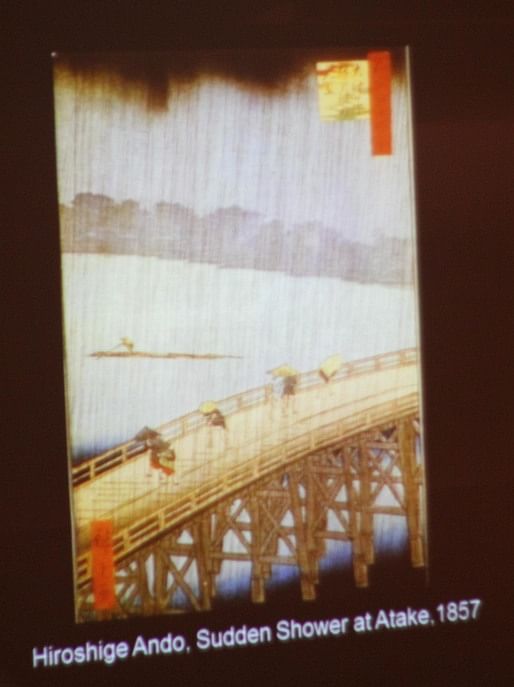
 7:04: Another western architect who greatly respected Japanese ways is Frank Lloyd Wright. KK is showing the Robie House.
7:04: Another western architect who greatly respected Japanese ways is Frank Lloyd Wright. KK is showing the Robie House.
Two artists KK couldn't have learned without are Okakura Tenshin, who wrote The Book of Tea, and the painter Hiroshige. FLW liked Hiroshige too and collected many of his paintings.

KK's Hiroshige musuem. In the village where it is, traditional life used to always rely on the mountain--energy, museum, everything--"and then they built shrine in the mountain. The message of the shrine was 'respect the mountain. We cannot live without the mountain.'" But this message was forgotten in the 20th century. The "sad system" of the 20th century was that 'all energy, all material' comes from Tokyo. For this project, KK wanted to use local materials, and most of it is from the village. Crazy beautiful.
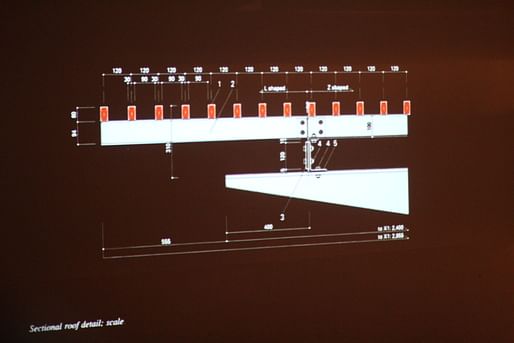 7:10: Discussion of FLW's use of a very soft stone in his Imperial Hotel. Others couldn't understand why he wanted to use that stone, as it wasn't seen as appropriate for an expensive hotel. But he wanted softness. Likewise, KK chose a soft stone (I think for his Chokkura Plaza project).
7:10: Discussion of FLW's use of a very soft stone in his Imperial Hotel. Others couldn't understand why he wanted to use that stone, as it wasn't seen as appropriate for an expensive hotel. But he wanted softness. Likewise, KK chose a soft stone (I think for his Chokkura Plaza project).
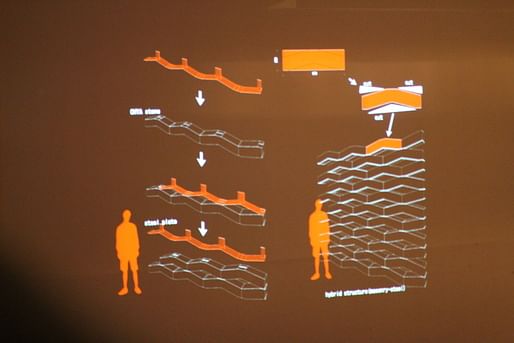

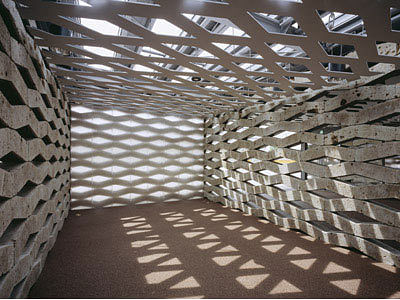 7:13: Using bamboo not as decoration but as formwork for concrete. KK loves bamboo, but its difficulty is that it tends to crack if it gets dry.
7:13: Using bamboo not as decoration but as formwork for concrete. KK loves bamboo, but its difficulty is that it tends to crack if it gets dry.
The floor is transparent, "people can communicate easily." And it's "good for the foot," as it looks rather...not flat.



 7:16: Inspiration from the 3D wood joint system (no nails) from 'Chidori' toys for a small temporary pavilion. His students assembled it in 5 hours.
7:16: Inspiration from the 3D wood joint system (no nails) from 'Chidori' toys for a small temporary pavilion. His students assembled it in 5 hours.



7:17: The next step was to develop this technique for a permanent building.

With regards to this next image, KK pointed out that a layer of glazing sits in the middle of this lattice wall, which is quite thick, and he said "this is the inside (pointing to the left) and this is the outside (pointing to the right)." It was the same phrase that SANAA used so often in describing their work; I think it points less to the slightly non-native use of English and more to the fact that in images of these buildings, you really can't tell what is inside or outside, or often even that these are "buildings" in any convention sense of enclosure at all.


Dazaifu Tenmangu Starbucks. "This is not decoration; this is the structure of the building. If these joints were 90 degrees, it wouldn't be so complicated, but at these angles it is complicated.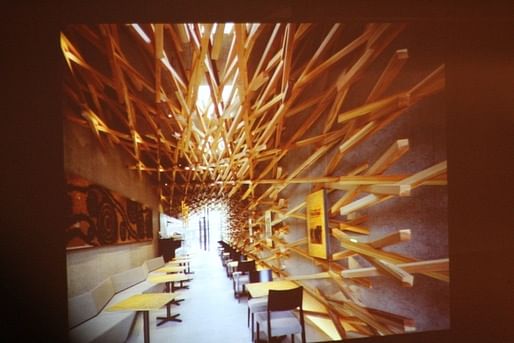
7:21: Another building beside an important temple. 8 houses piled up in Asakusa. "In 20th century, always repeating the same floors, always flat; but this is not like that."
7:22: Nagaoka City Hall, two hours from Tokyo by bullet train. "City hall in 20th century was outside of city; but for this project the mayors wanted to get the city hall in the center of city." KK's proposal was that the city hall is not a building but a "doma," a traditional house with its gathering space with an earth floor. "After the completion, every night the mayor call my mobile phone, saying...'many people are coming." [laughter.] Every night it's a popular place for the community.

 7:25: Besançon City Arts and Cultural Center, in France.
7:25: Besançon City Arts and Cultural Center, in France.
 7:27: Project in Marseille, using a recycled glass that KK found there, that resembles Japanese rice paper in its translucency.
7:27: Project in Marseille, using a recycled glass that KK found there, that resembles Japanese rice paper in its translucency.
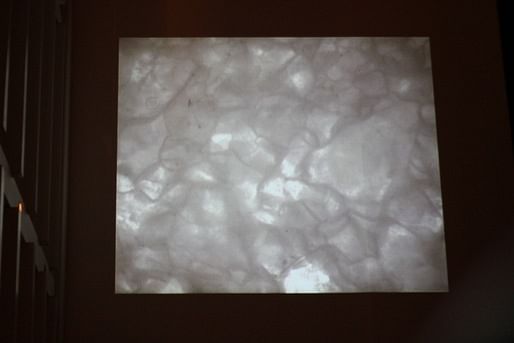
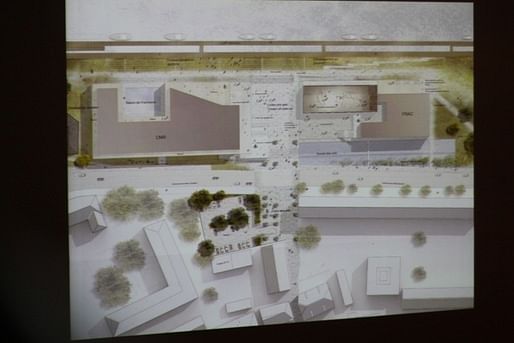 7:28: Italian project. Very soft Italian stone called "tuho" (?) that naturally supports growing vines; the building makes use of this phenomenon that KK found.
7:28: Italian project. Very soft Italian stone called "tuho" (?) that naturally supports growing vines; the building makes use of this phenomenon that KK found.





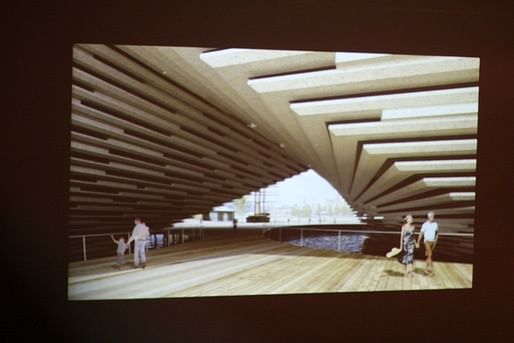 7:31: And some smaller experimental projects with his students. A "Teehaus" (tea house) in Frankfurt. "As a first proposal I showed him a tea house made of earth, and he said 'no...don't use natural material.' He said vandalism is strong in Germany, and he wanted a strong material like steel or concrete. KK said "I am not Tadao Ando, I won't build a tea house out of concrete." So they made an inflatable building that can be put up in 15 minutes. Small door 60 cm x 60 cm, which is traditional for teahouse.
7:31: And some smaller experimental projects with his students. A "Teehaus" (tea house) in Frankfurt. "As a first proposal I showed him a tea house made of earth, and he said 'no...don't use natural material.' He said vandalism is strong in Germany, and he wanted a strong material like steel or concrete. KK said "I am not Tadao Ando, I won't build a tea house out of concrete." So they made an inflatable building that can be put up in 15 minutes. Small door 60 cm x 60 cm, which is traditional for teahouse.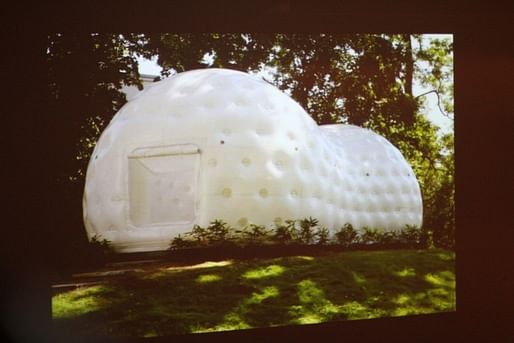

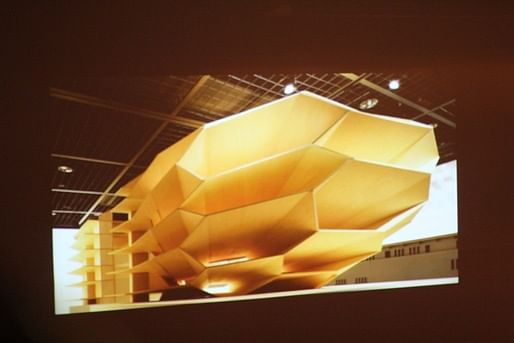
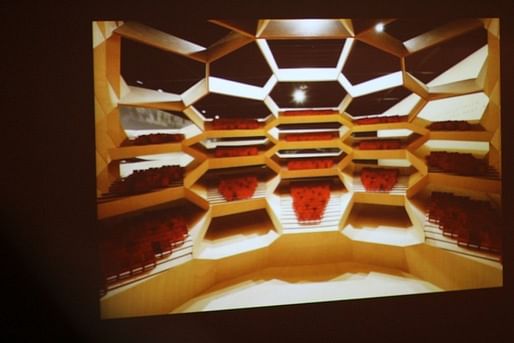 7:33: "Shape memory alloy" is an expensive material, and they used it in 2mm strands, built around a spherical formwork. The pavilion changes shape.
7:33: "Shape memory alloy" is an expensive material, and they used it in 2mm strands, built around a spherical formwork. The pavilion changes shape.
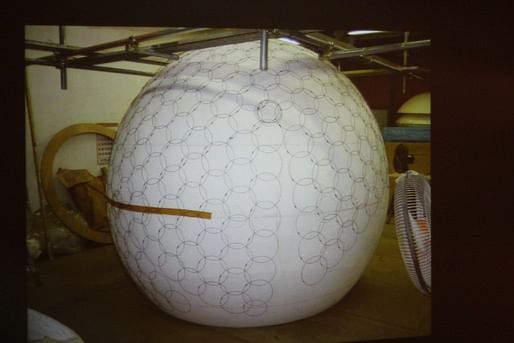

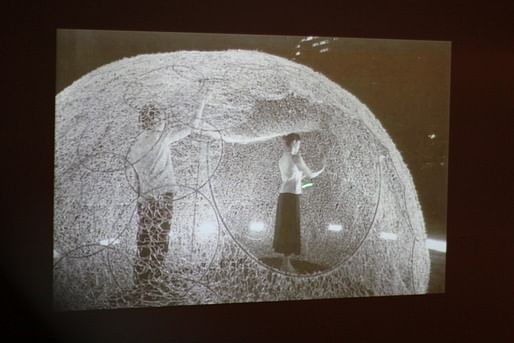 7:35: "Casa del tutto" was the theme for the Venice Bienelle. 'Casa' means 'umbrella' in Japanese, so that joke inspired their umbrella house, which is made of 15 umbrellas that KK designed.
7:35: "Casa del tutto" was the theme for the Venice Bienelle. 'Casa' means 'umbrella' in Japanese, so that joke inspired their umbrella house, which is made of 15 umbrellas that KK designed.

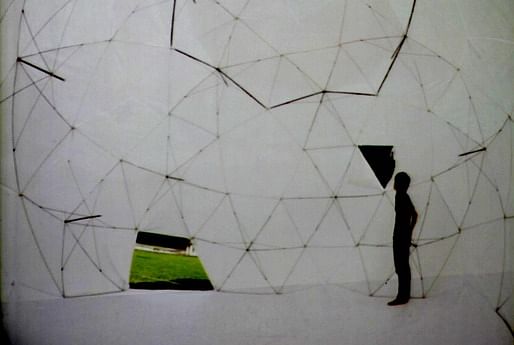
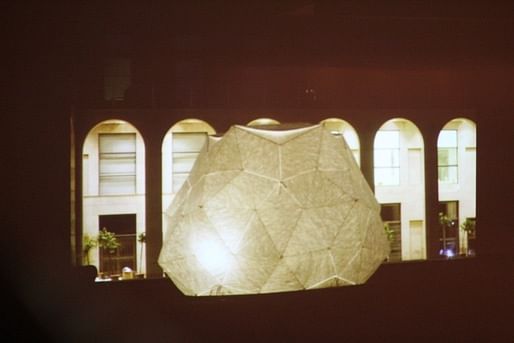 7:40: Another lesson from the earthquake: self-sufficiency. "All the infrastructures were out." Japanese infrastructures were so weak. This experimental house is made of plastic blocks that are filled with water and that interlock; water can flow between blocks to create circulation, which allows for heating of the different parts of the house.
7:40: Another lesson from the earthquake: self-sufficiency. "All the infrastructures were out." Japanese infrastructures were so weak. This experimental house is made of plastic blocks that are filled with water and that interlock; water can flow between blocks to create circulation, which allows for heating of the different parts of the house.
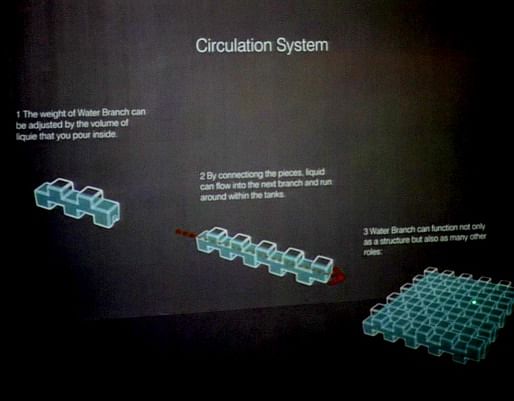



 7:41: Project with 'membrane' walls for an eco-village hotel.
7:41: Project with 'membrane' walls for an eco-village hotel.


 7:43: East Japan Project. industrial design project to help revitalize industry in areas hit by the tsunami. "Start from the bottom is a theme for our practice. Start from the material and small element, and start from the place. ...Thank you very much." [applause]
7:43: East Japan Project. industrial design project to help revitalize industry in areas hit by the tsunami. "Start from the bottom is a theme for our practice. Start from the material and small element, and start from the place. ...Thank you very much." [applause]

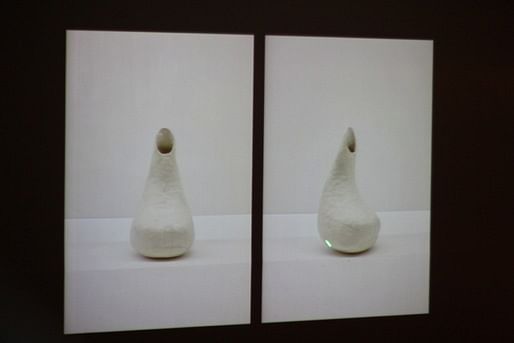 7:46: Question from the audience: You described a perfect level of integration with nature in the hedge at the FLW Imperial hotel, in which the bamboo was just bent, not cut; do you feel you've reached that level of integration in any of your own work? You work so beautifully with materials. Answer: That level of integration is very difficult...[no, not yet.]
7:46: Question from the audience: You described a perfect level of integration with nature in the hedge at the FLW Imperial hotel, in which the bamboo was just bent, not cut; do you feel you've reached that level of integration in any of your own work? You work so beautifully with materials. Answer: That level of integration is very difficult...[no, not yet.]
Q: What is more important: narrative, form, or material? KK: Integration of these things.
Q: You mentioned how after the fire in Tokyo, steel buildings took off; similarly, in Chicago. What do you think the role of disasters is in seeding these forms of architecture and what do you think will be the result of the tsunami? KK: The structure itself is not so important. If we can build a strong building in a bad location, it will be destroyed. The most important thing is to find the appropriate location. Research here is important, and also material; concrete is not always the most appropriate.
Q: Do you consider yourself part of a new generation of metabolist? KK: Ahhhhh...uh....I know them personally, very very interesting people, and [name] is still very active. But besides him. But the problem with metabolism is the size of the grain is too big; I want to find a smaller grain, finding an appropriate size for the environment. In that sense what I am doing is a kind of metabolism...but not a new metabolism.
Q: Your work is so eloquent in relating between nature and structure, but you work mostly in non-dense environments. Tokyo has an interesting relationship with cyclical processes of rebuilding. How do you imagine your [taller] buildings aging, in the most bustling city on earth, in Tokyo? KK: We also design in dense contexts, and also use natural materials there. I think the situation is the same as in a distant area. Aging and recycling is [part of the design]. For the bigger skyscrapers, the hurdle is getting higher and higher, but still I want to do a similar method. Q (follow up): Is it true that there's a 30 or 50 year rule in Tokyo where buildings have to be taken down and redone? KK: I don't think so, but as an average lifestyle, it's about 25 or 30 years. For the older buildings built before 1960s, the construction quality was very low, and the life is short. Now the life is getting longer and is same as here, I think.
Q: In your projects...[is there a shift from experimentation towards more conventional building practices in the trajectory of your career]? KK: For us, the dialogue between more experimental and more conventional projects is more important than before. As I started teaching...I wanted to make the collaboration closer and deeper than before.
End. Applause.
Thanks for reading!
Lian
This blog was most active from 2009-2013. Writing about my experiences and life at Harvard GSD started out as a way for me to process my experiences as an M.Arch.I student, and evolved into a record of the intellectual and cultural life of the Cambridge architecture (and to a lesser extent, design/technology) community, through live-blogs. These days, I work as a data storyteller (and blogger at Littldata.com) in San Francisco, and still post here once in a while.



1 Comment
love this line from Q+A
KK said "I am not Tadao Ando, I won't build a tea house out of concrete." also the way he critiques the metabolists re: the issue of scale as not fine enough "grain"...
Block this user
Are you sure you want to block this user and hide all related comments throughout the site?
Archinect
This is your first comment on Archinect. Your comment will be visible once approved.